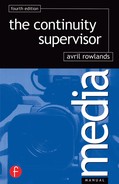Let us, as an example, take a television documentary off-line edited in one of the latest generation Avids. With a shooting ratio of 20:1, the pictures were digitised into the machine at low non-broadcast quality. When the creative decisions have been made and the picture has been locked-off, the editor takes the alarming step of deleting all the pictures from the system! He or she then tells the machine to re-digitise the pictures, this time at broadcast quality, with, say, a one-second handle at the beginning and end of each shot. (A ‘handle’ is a small overlap to allow slight changes to be made.) The computer will then ask for the source tapes to be loaded into a VTR in order and will only digitise those parts of the shots used in the finished programme, plus a little bit at each end.
You could ask why bother to go through the process of digitising the pictures twice, once at off-line and once at on-line quality. The reason is that with a television documentary with a ratio of 20:1, the amount of disk storage needed to accommodate all the shot material at broadcast quality would be enormous. If the shooting ratio is quite small, as in the case of short magazine items for TV programmes, and there is enough available storage, it may well be that the editor digitises the rushes at on-line quality and edits the item as a creative on-line.
Once the shots have all been re-digitised at broadcast quality and the computer has arranged them to match the off-line edit, the programme is said to have been ‘conformed’. However, at this point it only exists inside the Avid and needs to be played out on to a VTR before it exists in a linear form.
It is not necessary, of course, to conform a programme in the same machine on which it was off-line edited. It might well be that our television documentary had been off-line edited in another, non-broadcast Avid, in which case it would be necessary to import the project into the on-line machine before re-digitising the pictures. Alternatively, if the television documentary had been offline edited on a Lightworks system, the pictures could be conformed after loading an EDL from the Lightworks into the Avid on-line machine.
There are several non-linear on-line systems apart from Avid.
After completing an off-line non-linear edit and generating an EDL, another route is to conform the pictures in a linear on-line suite, whereby shots are copied from one VTR to another in the right order. For various reasons this is the route most often used for television drama. In addition, most television programmes conformed in non-linear on-line suites tend to move to a linear on-line edit for final titling and versioning.
